King County Civic Ground
Seattle, King County, WAPublic facilities, Public space, Infrastructure
Spread over eight acres of land, with a total of 2.3 million existing square feet of space in buildings that range in age from 17 years old to 112 years old, most of King County civic campus facilities in downtown Seattle have become functionally obsolete, or are facing rapidly escalating, costly maintenance and repairs that may be financially unsustainable.
Northwest Studio is leading the planning initiative to provide the public and King County leaders with viable strategies for campus investments, including county facilities and public spaces.
Key to this effort is a focus on planning new environments that are designed for equity and fairness, that build respectful civic experiences, that create resilient working places, create beautifully restorative environments, and deliver financially sound projects.
Northwest Studio is leading the planning initiative to provide the public and King County leaders with viable strategies for campus investments, including county facilities and public spaces.
Key to this effort is a focus on planning new environments that are designed for equity and fairness, that build respectful civic experiences, that create resilient working places, create beautifully restorative environments, and deliver financially sound projects.


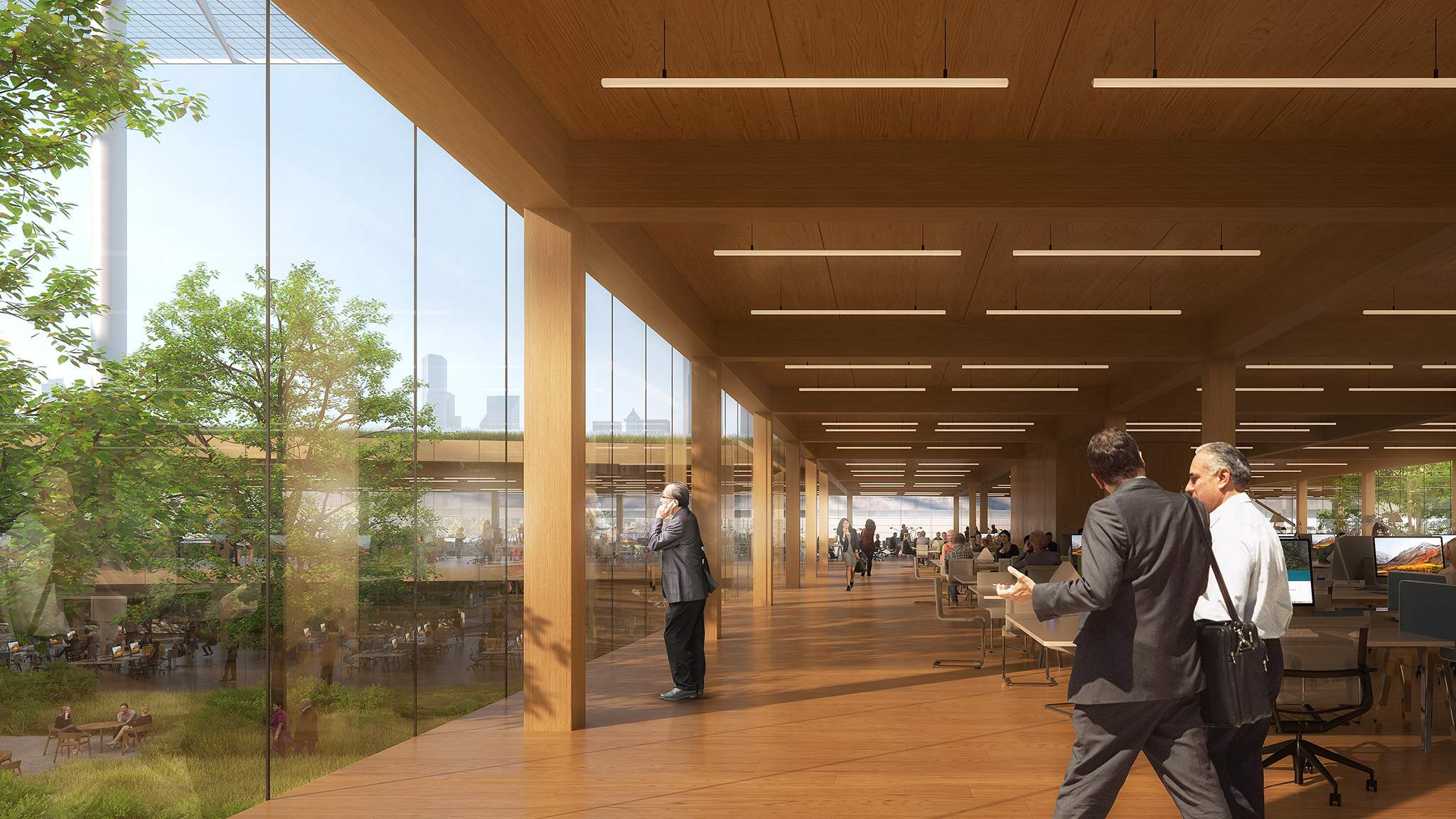
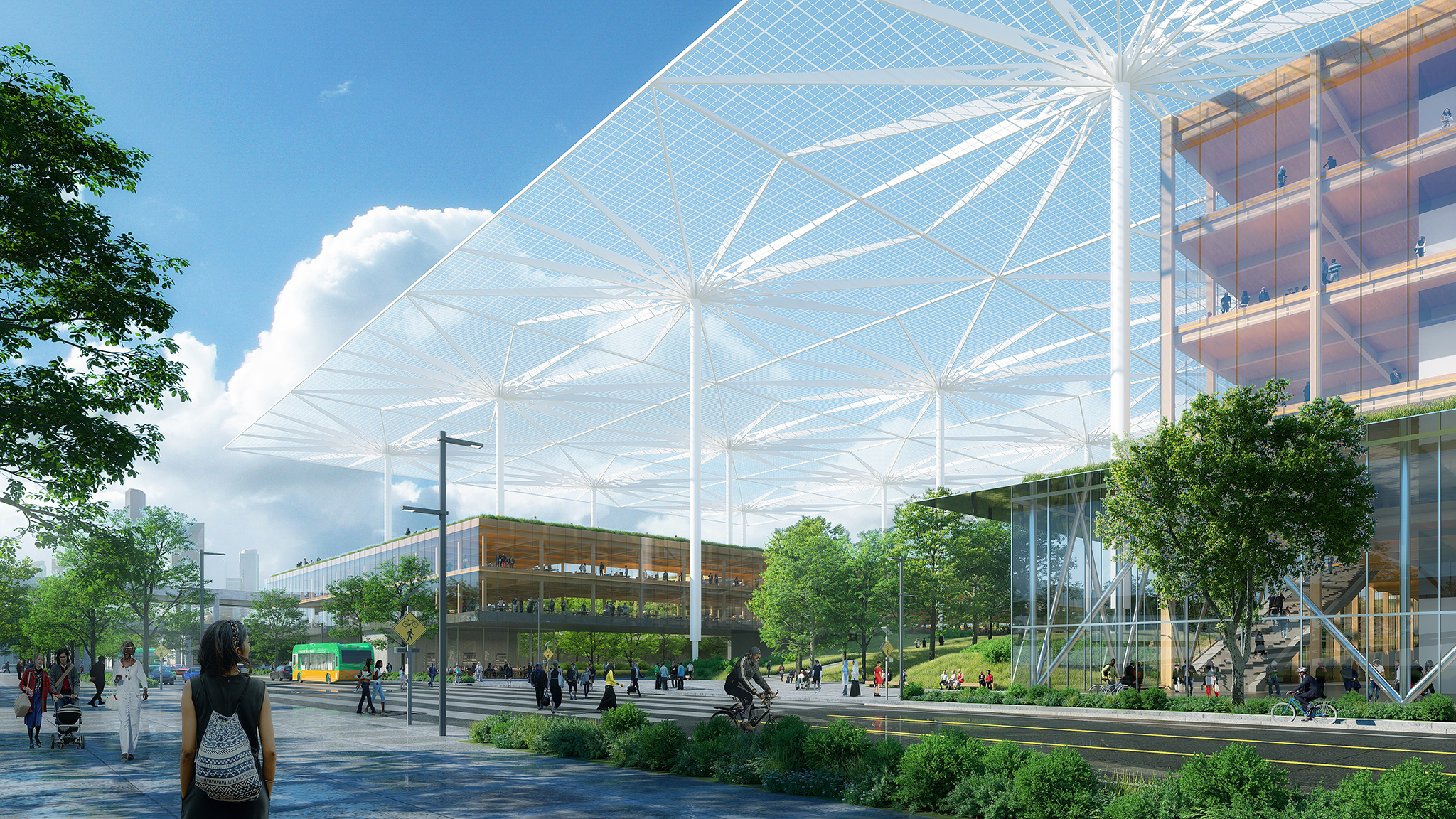

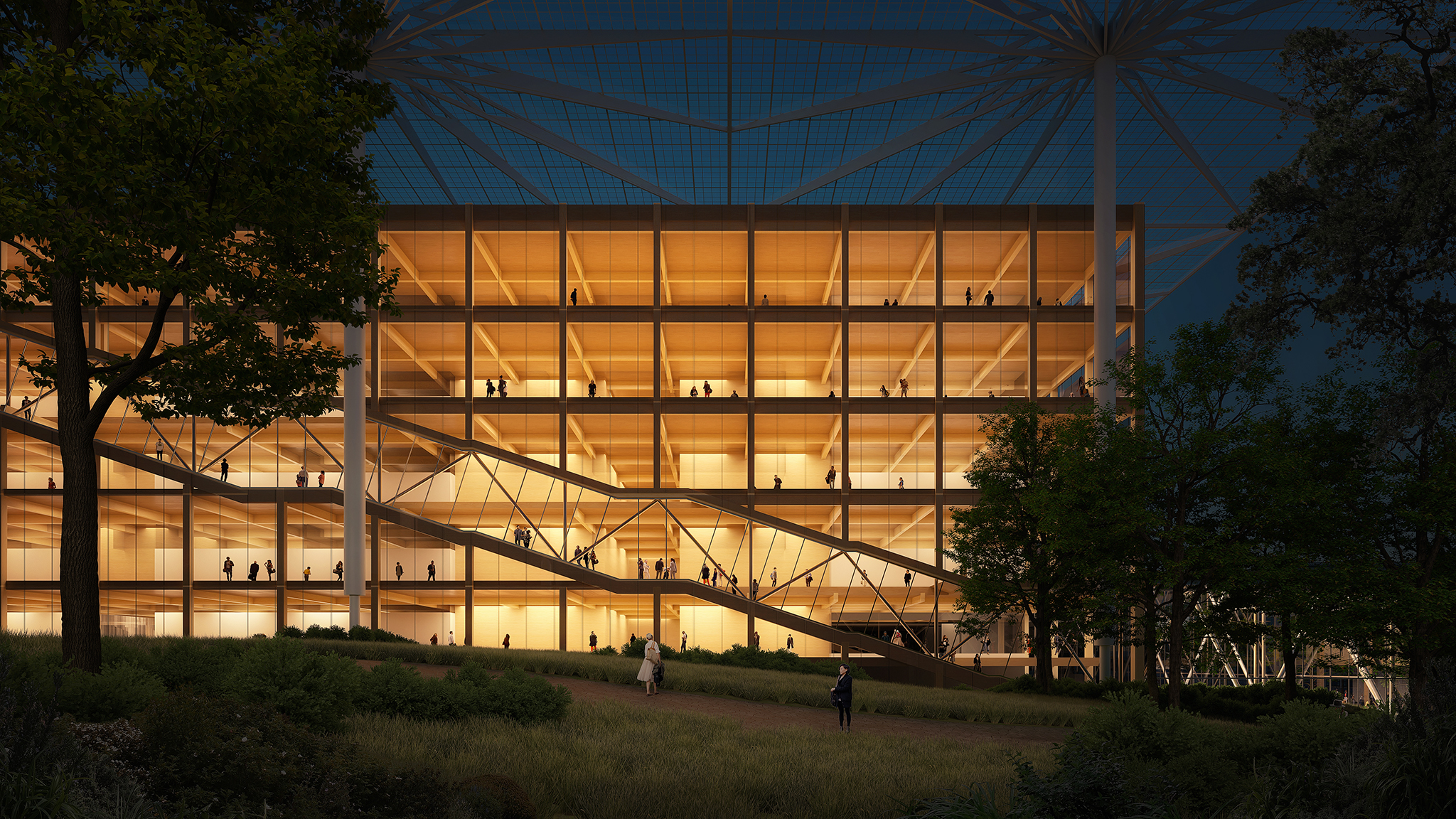

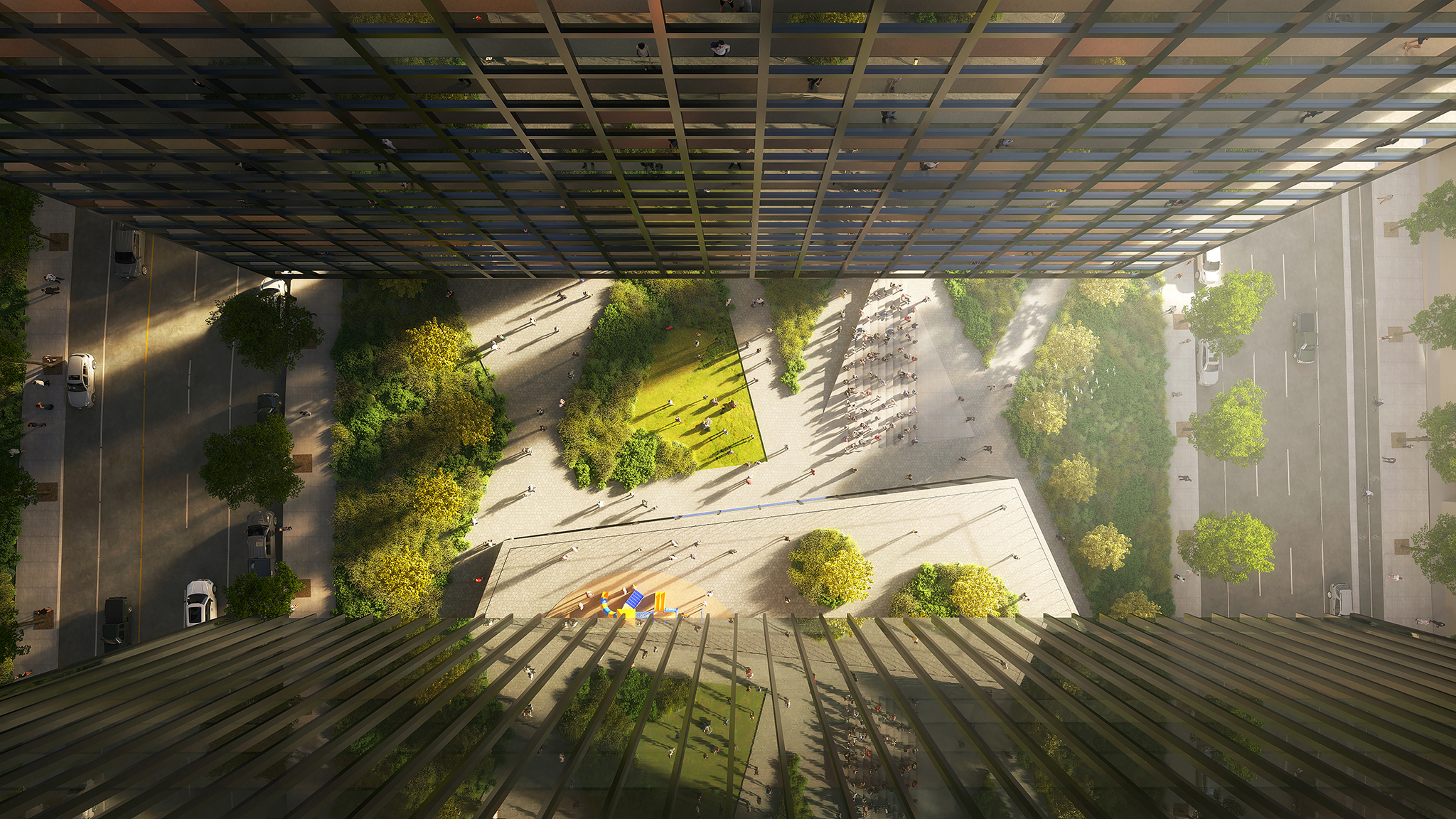

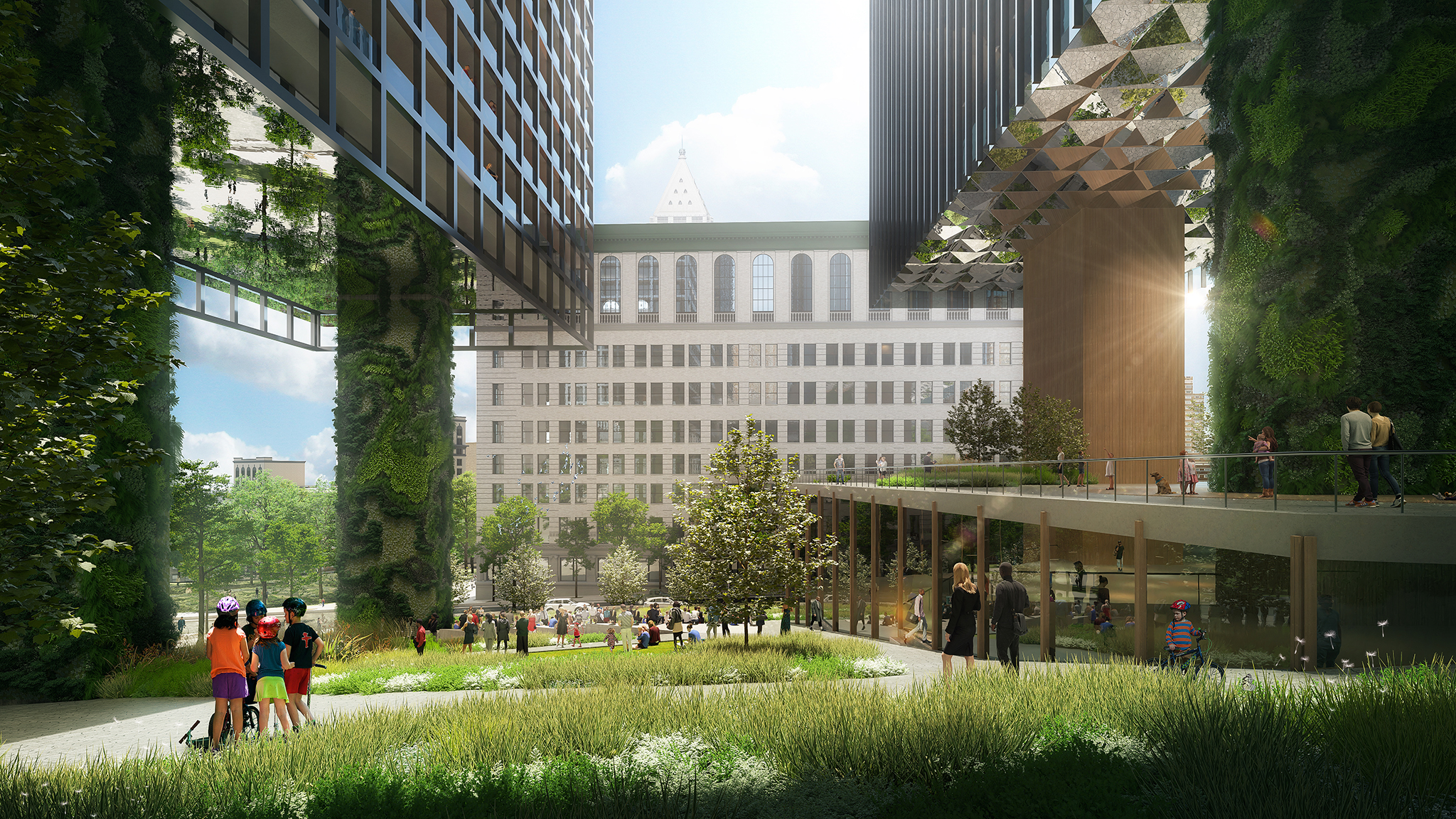
Existing Conditions
King County owns and operates several facilities in downtown Seattle, most of which are on a civic campus centered on Fourth Avenue between James Street and Yesler Way. These include the King County Courthouse, King County Administration Building, King County Correctional Facility, Chinook Building, and Yesler Building. The county also owns King Street Center, located in Pioneer Square.
Over the decades, King County has made investments in these buildings to keep providing services to residents. However, many of them are underutilized, functionally obsolete, or are facing costly maintenance and repairs that may be financially unsustainable. Not only are some of these buildings at the end of their useful life, the area around the campus is often perceived as being unsafe.
New approaches to delivering health and human services, law enforcement, and criminal justice are also driving change at King County, and the COVID-19 pandemic has moved governments at all levels to rethink how they deliver services to the public. The Civic Campus Initiative looks ahead to identify opportunities to deploy county services, leverage the value of county real estate assets, improve personal safety and security, and better engage and complement surrounding neighborhoods.
The current civic campus is spread over eight acres of land. There are eight buildings and ten sites, with a total of 2.3 million square feet of space in existing buildings.
King County Executive Dow Constantine and the King County Council retained Northwest Studio, a practice of architects and urban designers based in Seattle, to lead the study. The plan will provide the public and county leaders with viable strategies for campus investments, including County facilities and public spaces.
Over the decades, King County has made investments in these buildings to keep providing services to residents. However, many of them are underutilized, functionally obsolete, or are facing costly maintenance and repairs that may be financially unsustainable. Not only are some of these buildings at the end of their useful life, the area around the campus is often perceived as being unsafe.
New approaches to delivering health and human services, law enforcement, and criminal justice are also driving change at King County, and the COVID-19 pandemic has moved governments at all levels to rethink how they deliver services to the public. The Civic Campus Initiative looks ahead to identify opportunities to deploy county services, leverage the value of county real estate assets, improve personal safety and security, and better engage and complement surrounding neighborhoods.
The current civic campus is spread over eight acres of land. There are eight buildings and ten sites, with a total of 2.3 million square feet of space in existing buildings.
King County Executive Dow Constantine and the King County Council retained Northwest Studio, a practice of architects and urban designers based in Seattle, to lead the study. The plan will provide the public and county leaders with viable strategies for campus investments, including County facilities and public spaces.
Information
Location
Seattle, King County, Washington
Client
King County︎︎︎
Status
Phase I: 2018-2019
Phase II: 2020-Ongoing
Program
Offices, Council facilities, Civil and Criminal Legal System Facilities, Mobility infrastructure, Public open space
Size:
2,750,000 - 4,300,000gsf; 8.3ac (10 urban blocks)
Collaborators
Facility Programmer: Clark Barnes︎︎︎
Economics & Finance: ECONorthwest︎︎︎
Public Affairs: Cocker Fennessey︎︎︎
Community Engagement: Stepherson Associates︎︎︎
Real Estate Analysis: Kinzer Partners︎︎︎
Environmental Design: Atelier Ten︎︎︎
Mobility: Nelson Nygaard︎︎︎
Landscape Architecture: Communita Atelier︎︎︎
Cost Estimation: DCW Cost Management︎︎︎
Justice Systems Consultant: CGL︎︎︎
Visualization: Luxigon︎︎︎
Aerial Photography: Skypix︎︎︎
Seattle, King County, Washington
Client
King County︎︎︎
Status
Phase I: 2018-2019
Phase II: 2020-Ongoing
Program
Offices, Council facilities, Civil and Criminal Legal System Facilities, Mobility infrastructure, Public open space
Size:
2,750,000 - 4,300,000gsf; 8.3ac (10 urban blocks)
Collaborators
Facility Programmer: Clark Barnes︎︎︎
Economics & Finance: ECONorthwest︎︎︎
Public Affairs: Cocker Fennessey︎︎︎
Community Engagement: Stepherson Associates︎︎︎
Real Estate Analysis: Kinzer Partners︎︎︎
Environmental Design: Atelier Ten︎︎︎
Mobility: Nelson Nygaard︎︎︎
Landscape Architecture: Communita Atelier︎︎︎
Cost Estimation: DCW Cost Management︎︎︎
Justice Systems Consultant: CGL︎︎︎
Visualization: Luxigon︎︎︎
Aerial Photography: Skypix︎︎︎
Related
Reimagine Wenatchee Master Plan
Wenatchee, WATransit Facilities, Neighborhood Amenities, Public Space, Infrastructure
The Reimagine Wenatchee Master Plan studies
considers a variety of catalytic opportunities within the waterfront, downtown and warehouse districts to reveal and leverage the threads that can tie several distinct but interrelated Cornerstone projects, regulatory frameworks, and communities together into a cohesive plan. The masterplan will be used to identify improvement opportunity areas, outline a prioritization list for these improvements, and ensure consistency with community visioning efforts aimed at increasing opportunities for business and economic expansion activity, safety, aesthetics, infrastructure allocation and utilization, and continued economic revival.

Reports
Information
Location
Wenatchee, Washington
Client
City of Wenatchee︎︎︎
Status
Masterplan: 2023-Ongoing
Program
Community Visioning & Goals, Strategic Framework, Transportation Improvement Alternatives, Conceptual Streetscape Designs, Land Use Recommendations
Size:
34ac
Collaborators
Economic Analysis: ECONorthwest︎︎︎
Mobility: Nelson Nygaard︎︎︎
Civil Engineering: Perteet︎︎︎
Wenatchee, Washington
Client
City of Wenatchee︎︎︎
Status
Masterplan: 2023-Ongoing
Program
Community Visioning & Goals, Strategic Framework, Transportation Improvement Alternatives, Conceptual Streetscape Designs, Land Use Recommendations
Size:
34ac
Collaborators
Economic Analysis: ECONorthwest︎︎︎
Mobility: Nelson Nygaard︎︎︎
Civil Engineering: Perteet︎︎︎
Related
Spring District Hub
Spring District, Bellevue, WATransit Facilities, Neighborhood Amenities, Public Space, Core & Shell, Commercial
The Spring District, in Bellevue, Washington, used to be a 36-acre warehouse and distribution center. Grey metal warehouses with blocks-and-blocks of covered loading docks and wide unmarked asphalt service roads. It was utilitarian and sensible. It was a distinctly American vernacular.
Today, warehouses are giving way to apartments, offices, and technology labs, and the expansive service roads are becoming a variegated network of new streets and public spaces. Within this enormous urban landscape we were asked to create a tiny workhorse of a building for vital programs. Commuter bicycle facilities, transit operator facilities, commercial and retail spaces, restaurant spaces, and a public open space needed to fit into two-stories on one small and eccentrically shaped site located at the most visible threshold to the district.
We brought these very different programs together into a design that draws from the warehouse district’s history of unapologetically rational forms and simple, durable, materials to bridge the vernacular of a past era with the emerging identity of a new and growing neighborhood.
Today, warehouses are giving way to apartments, offices, and technology labs, and the expansive service roads are becoming a variegated network of new streets and public spaces. Within this enormous urban landscape we were asked to create a tiny workhorse of a building for vital programs. Commuter bicycle facilities, transit operator facilities, commercial and retail spaces, restaurant spaces, and a public open space needed to fit into two-stories on one small and eccentrically shaped site located at the most visible threshold to the district.
We brought these very different programs together into a design that draws from the warehouse district’s history of unapologetically rational forms and simple, durable, materials to bridge the vernacular of a past era with the emerging identity of a new and growing neighborhood.
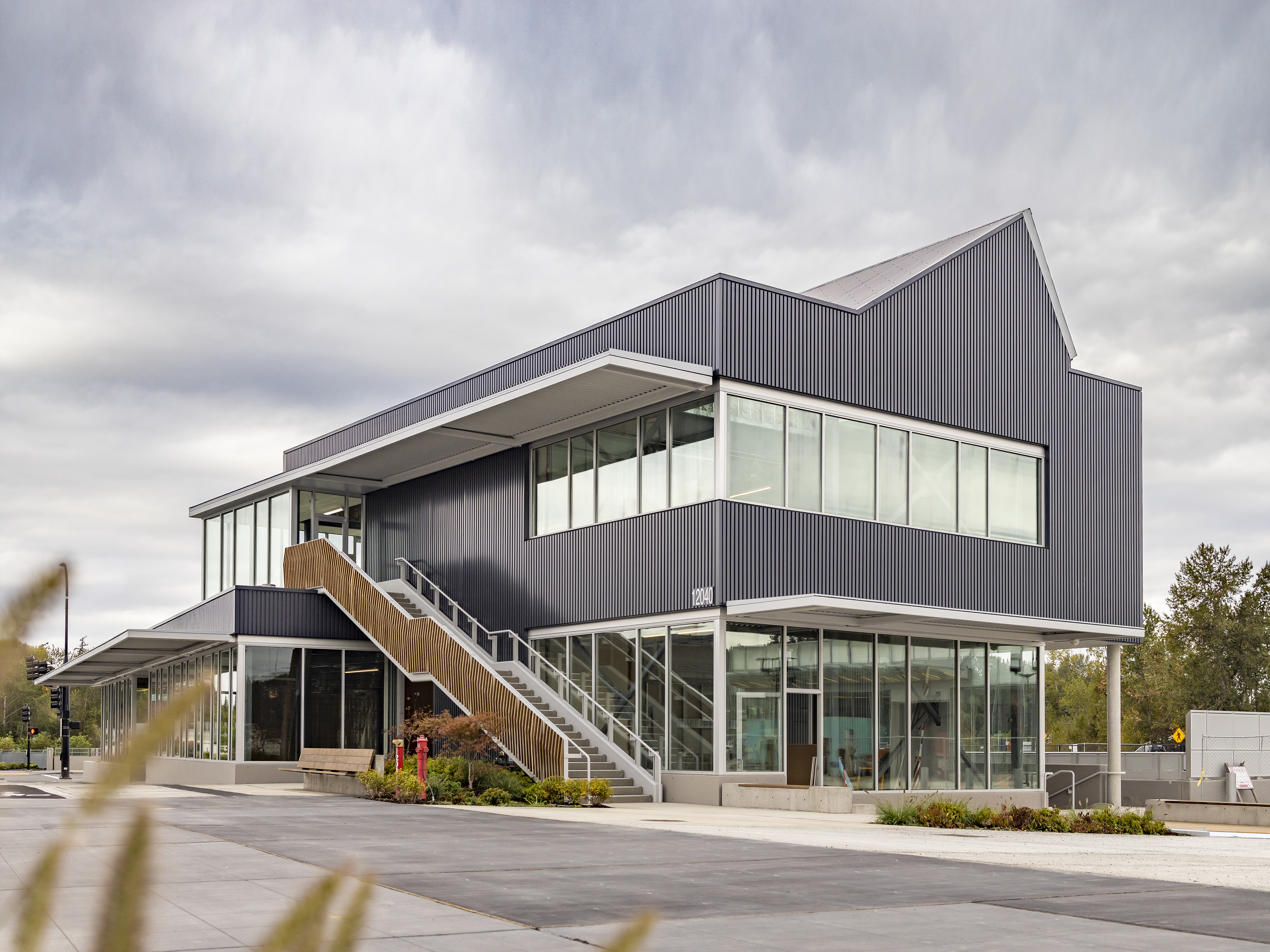
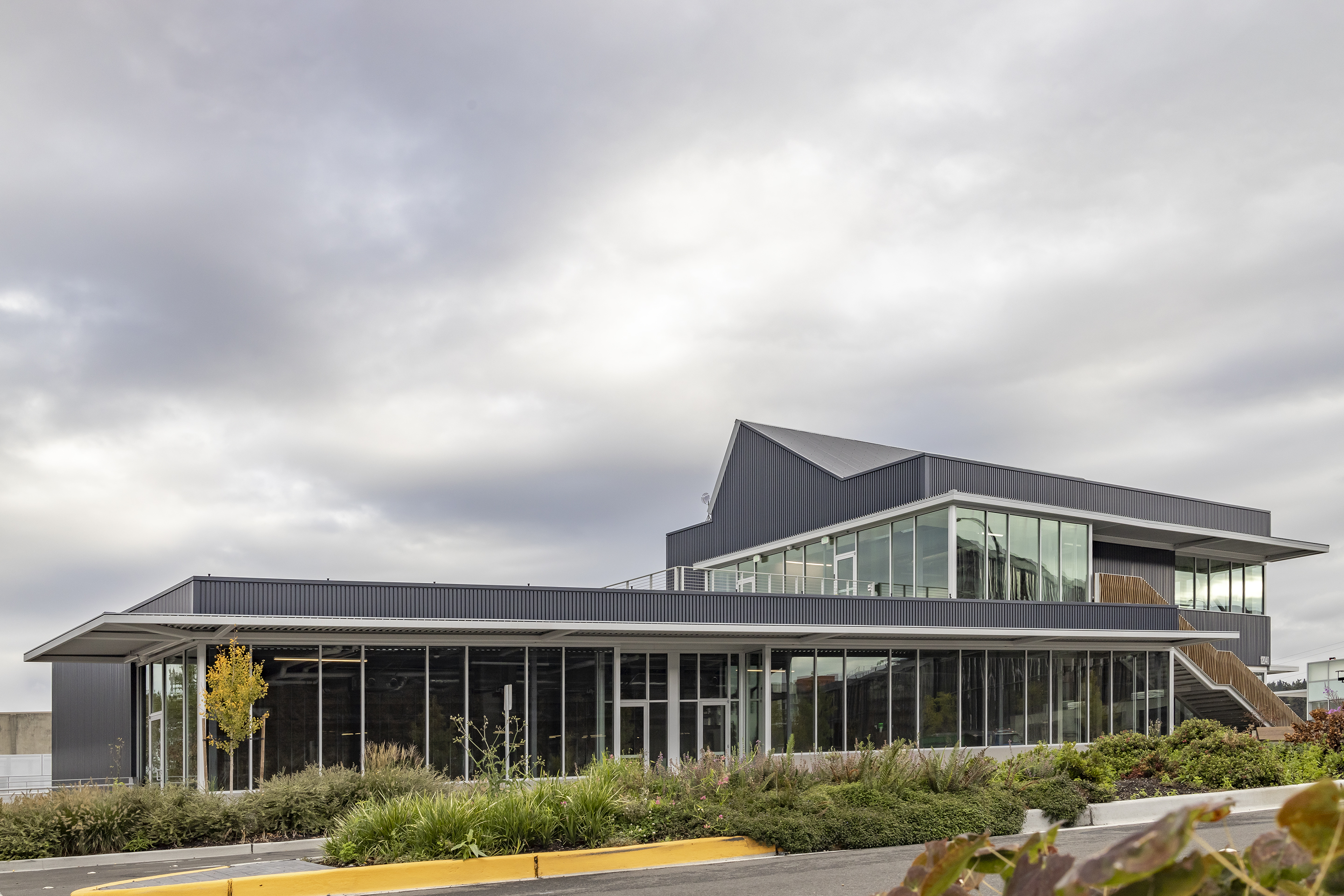
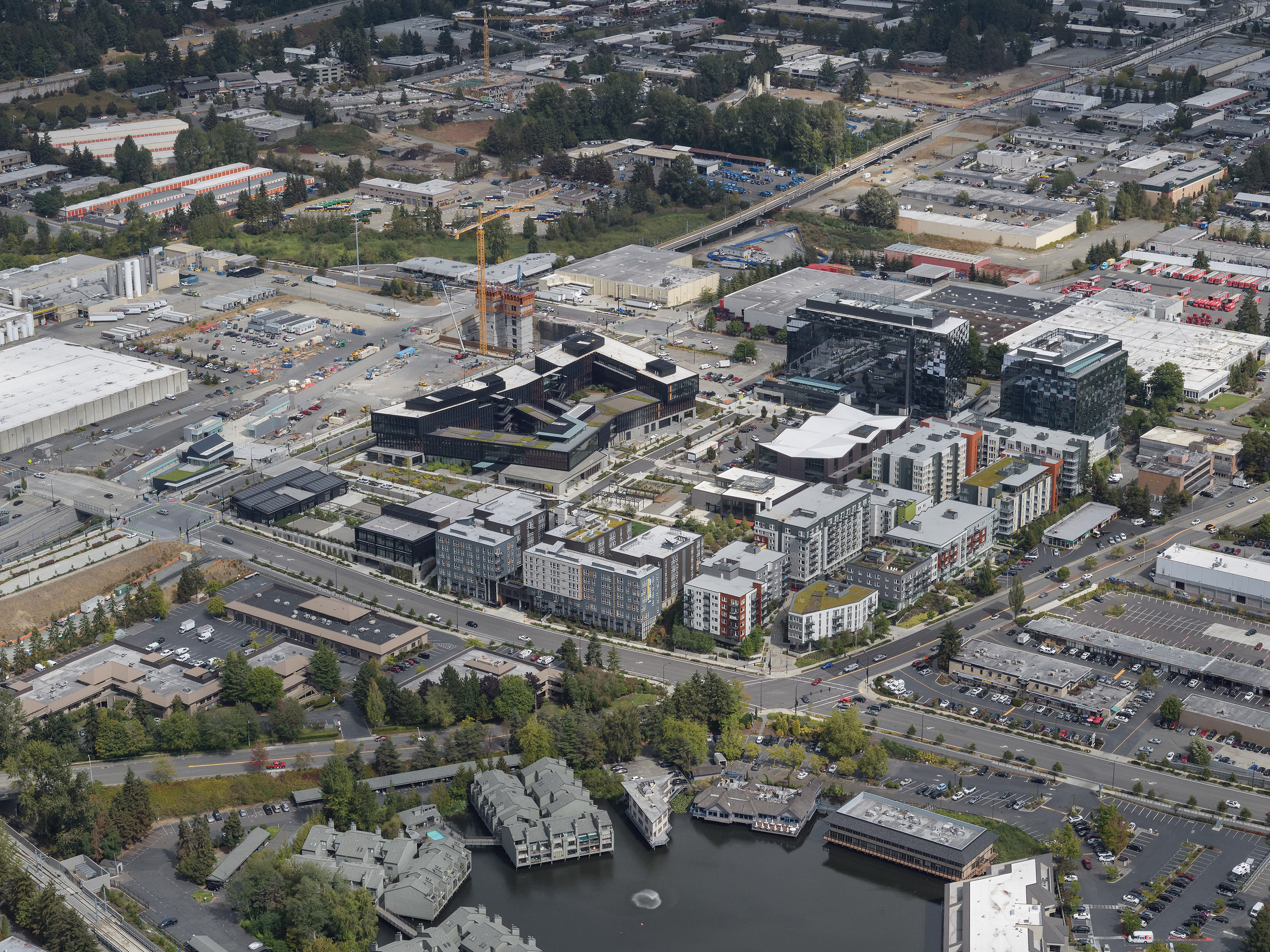
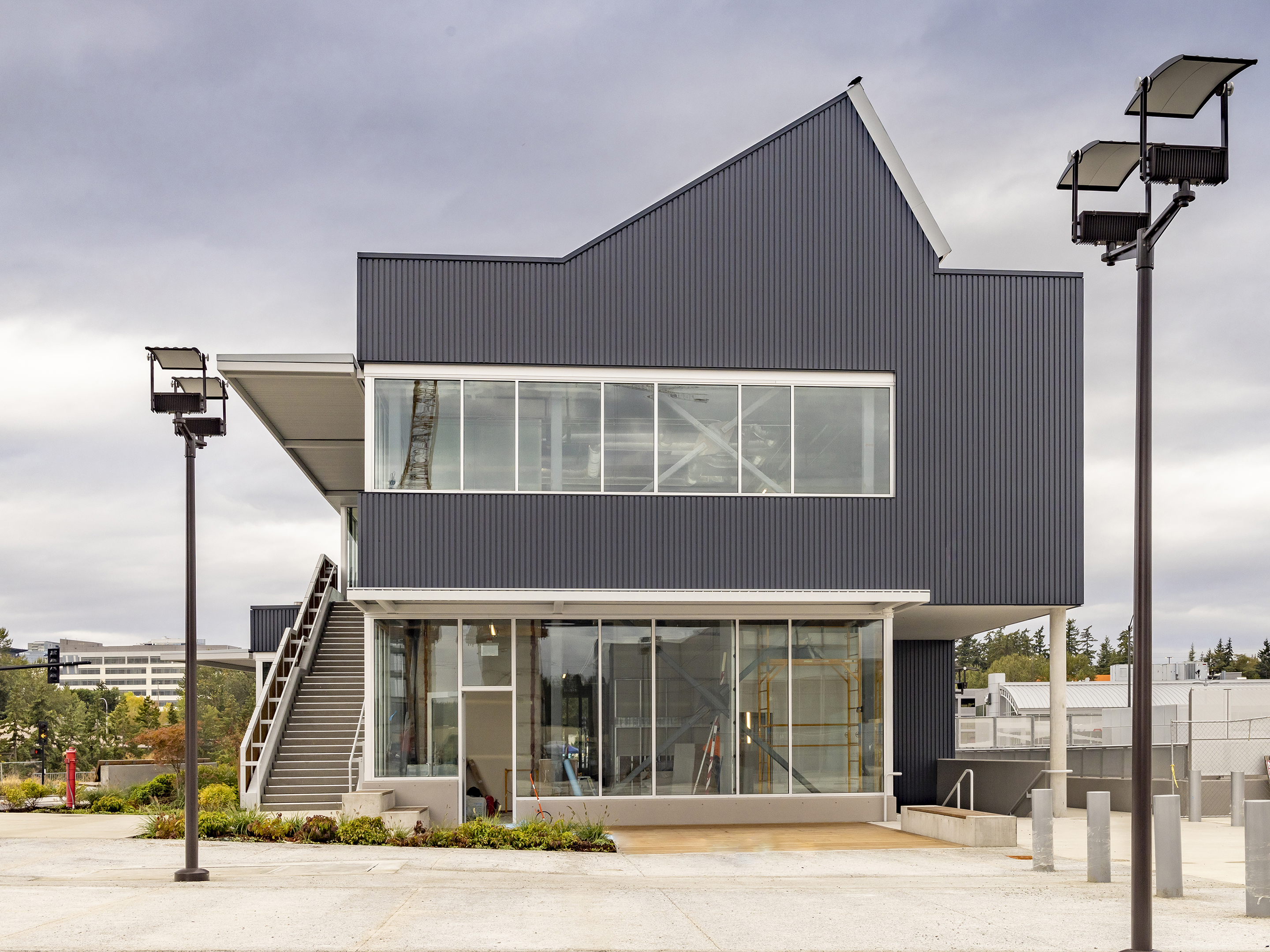
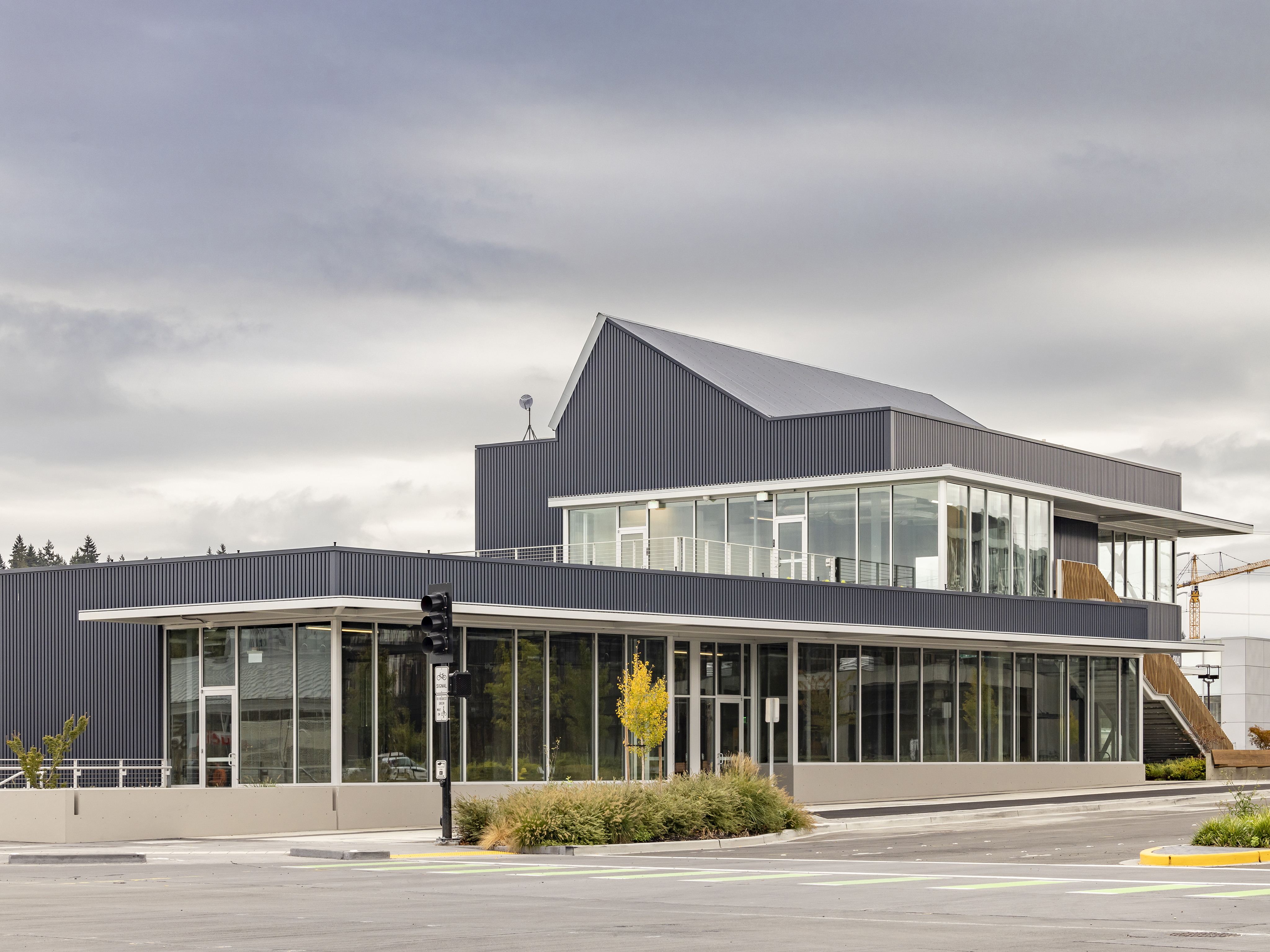
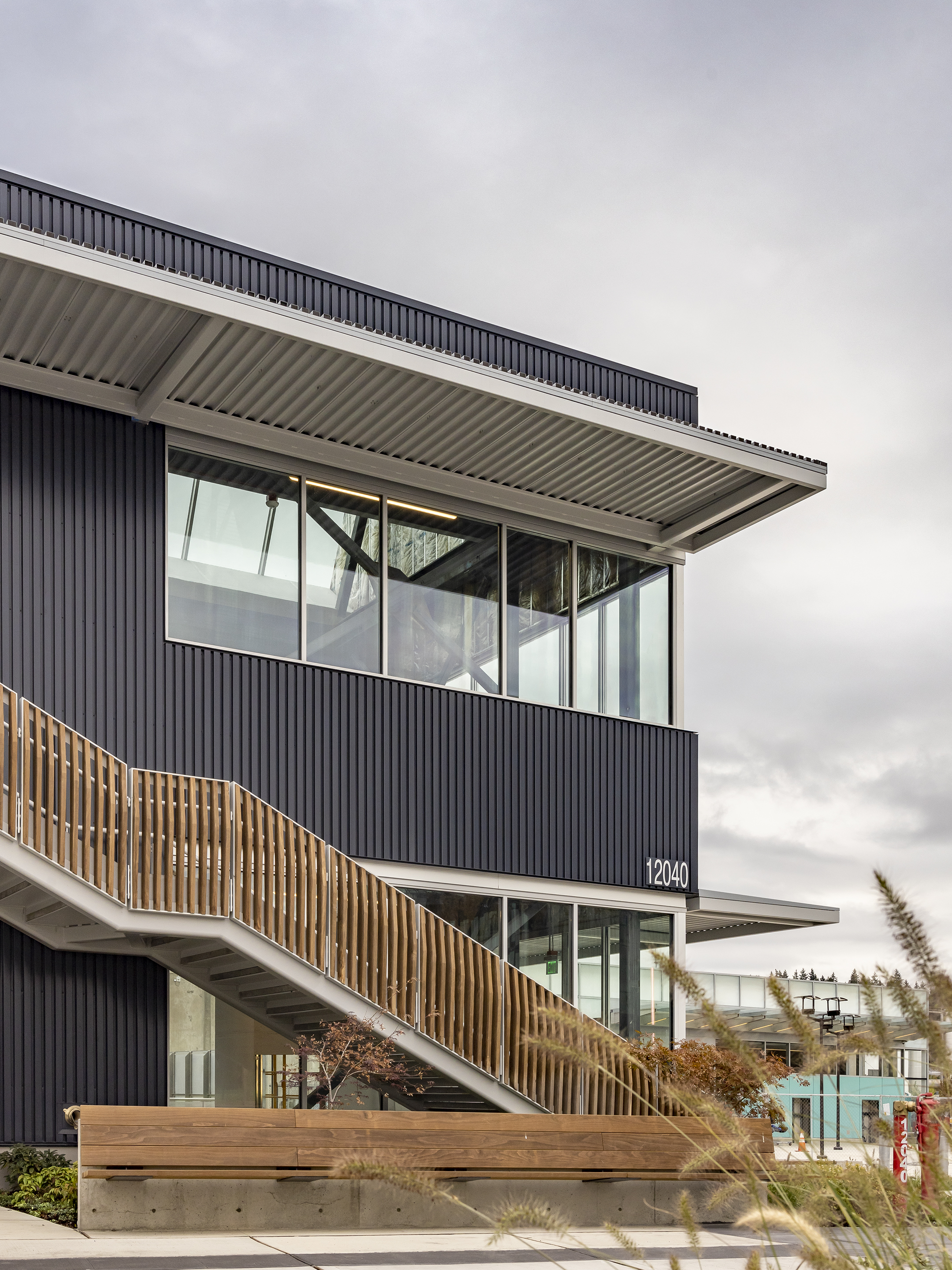


References and Diagrams
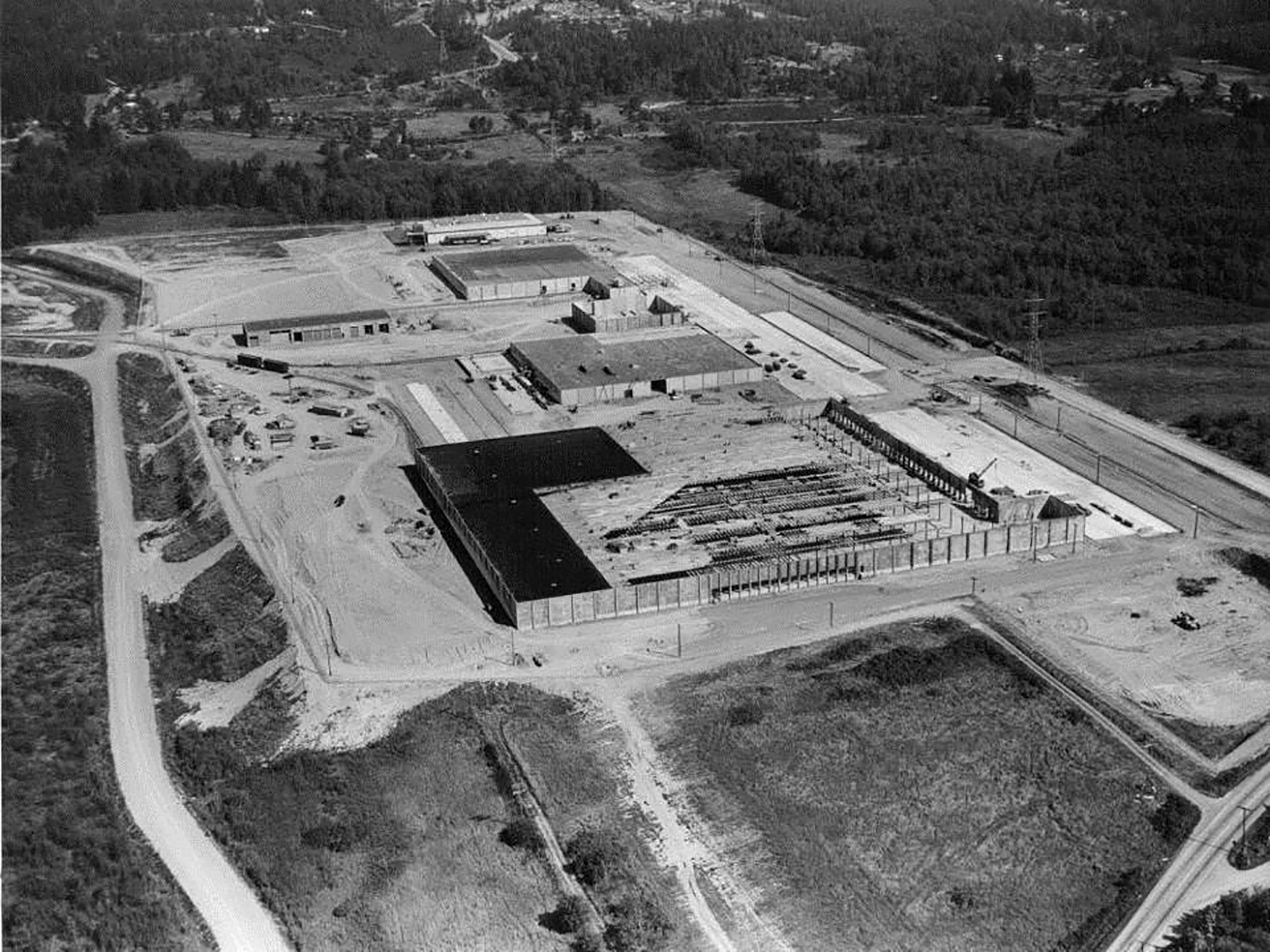
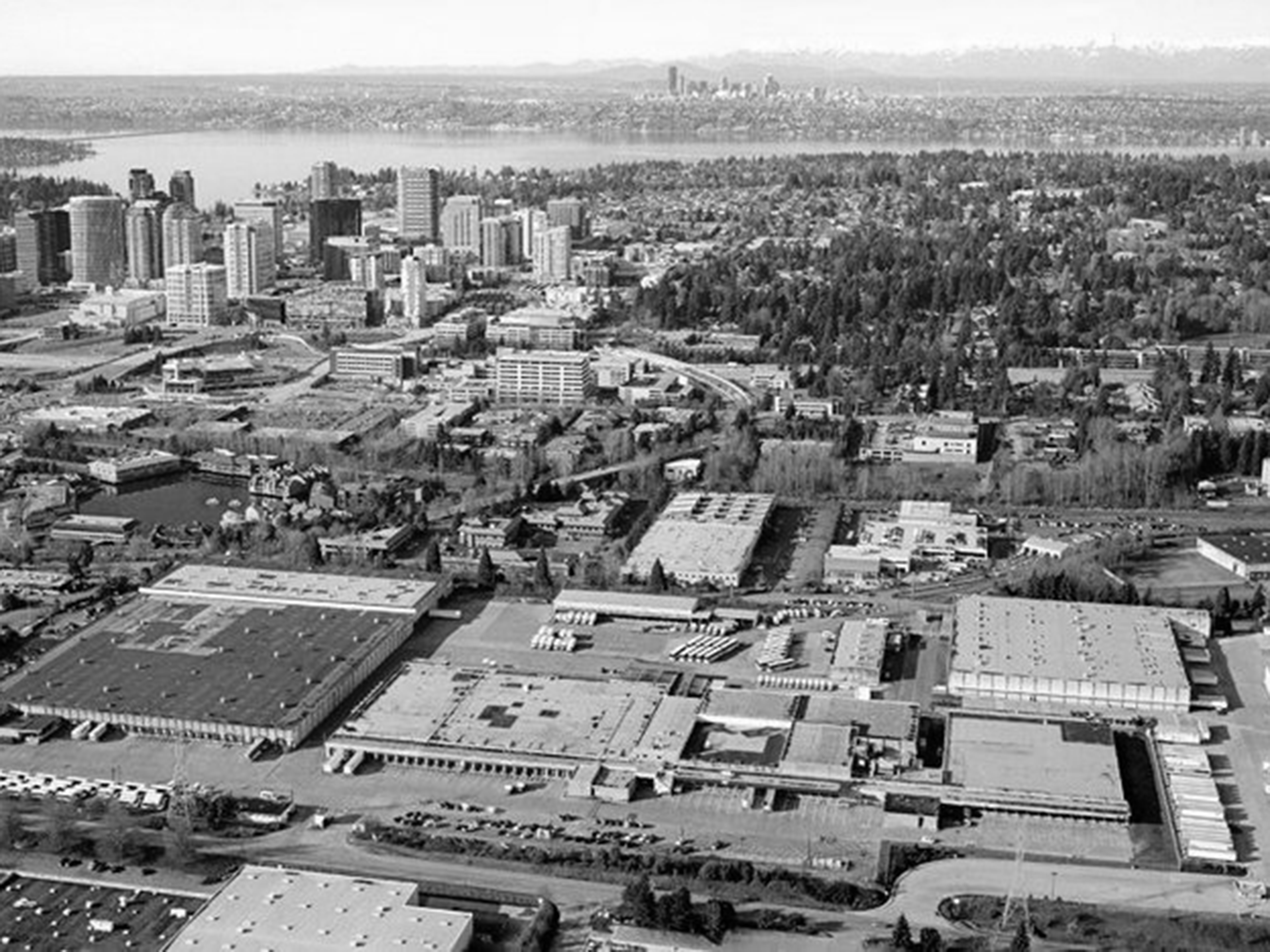
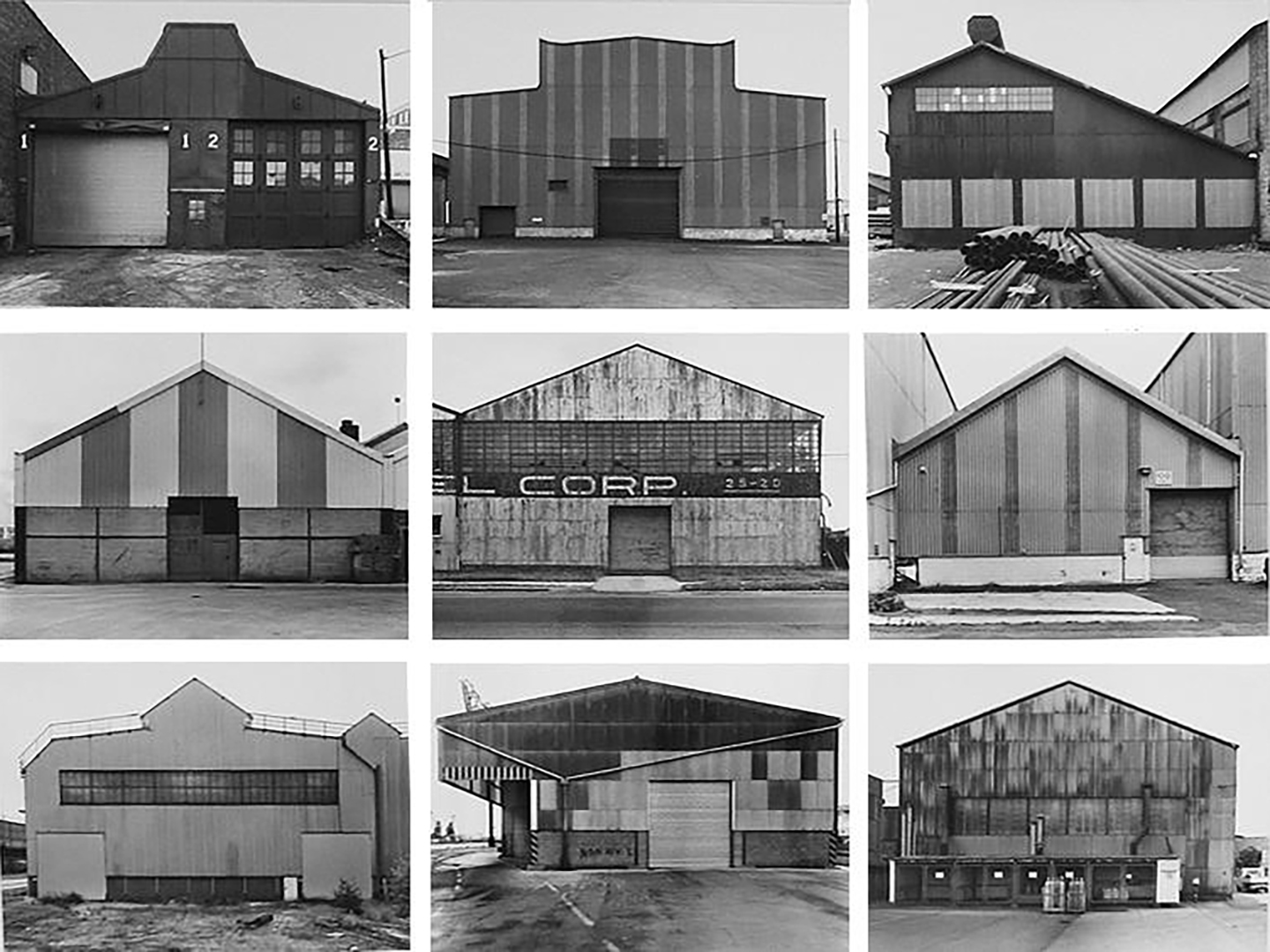
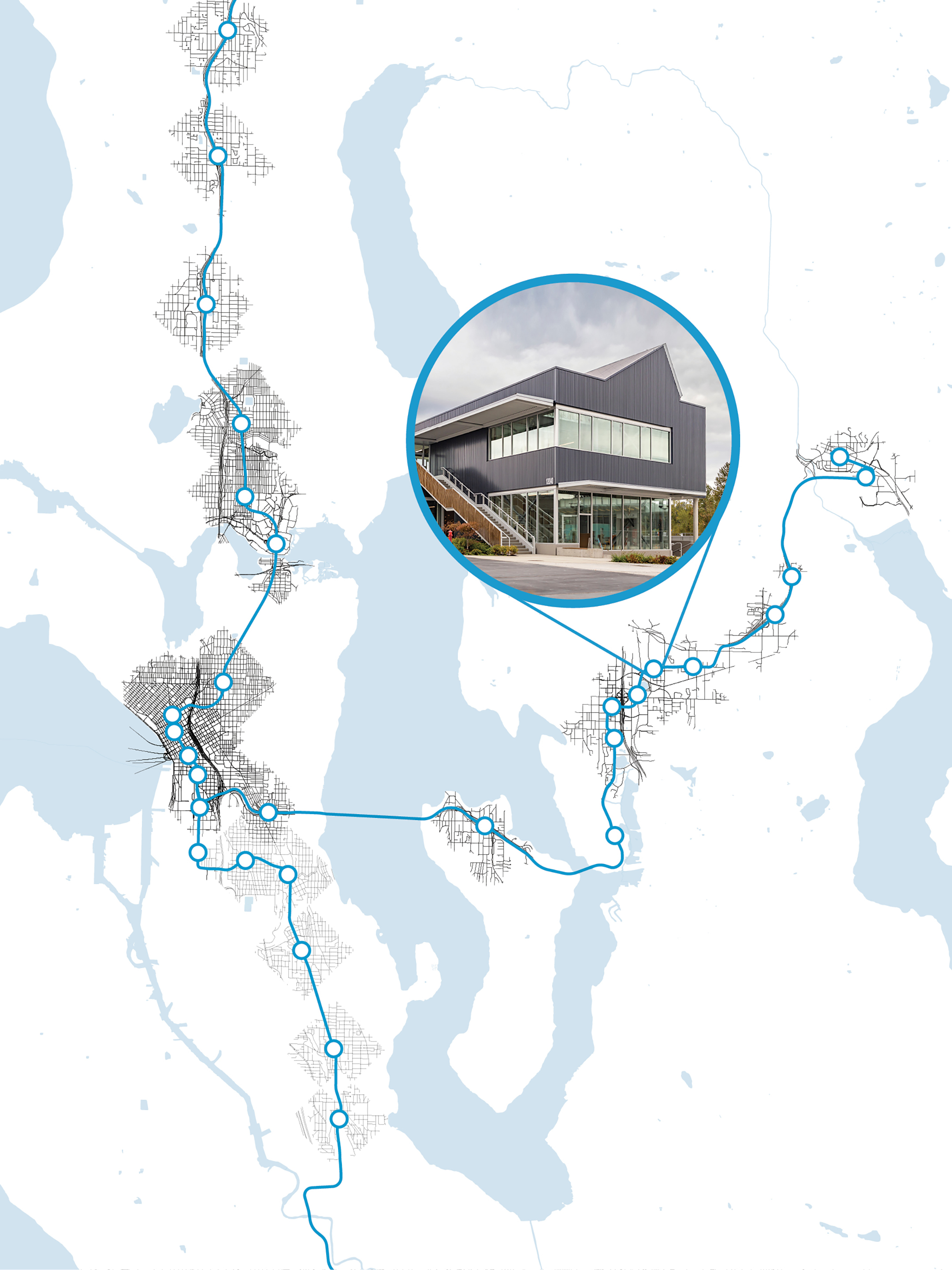
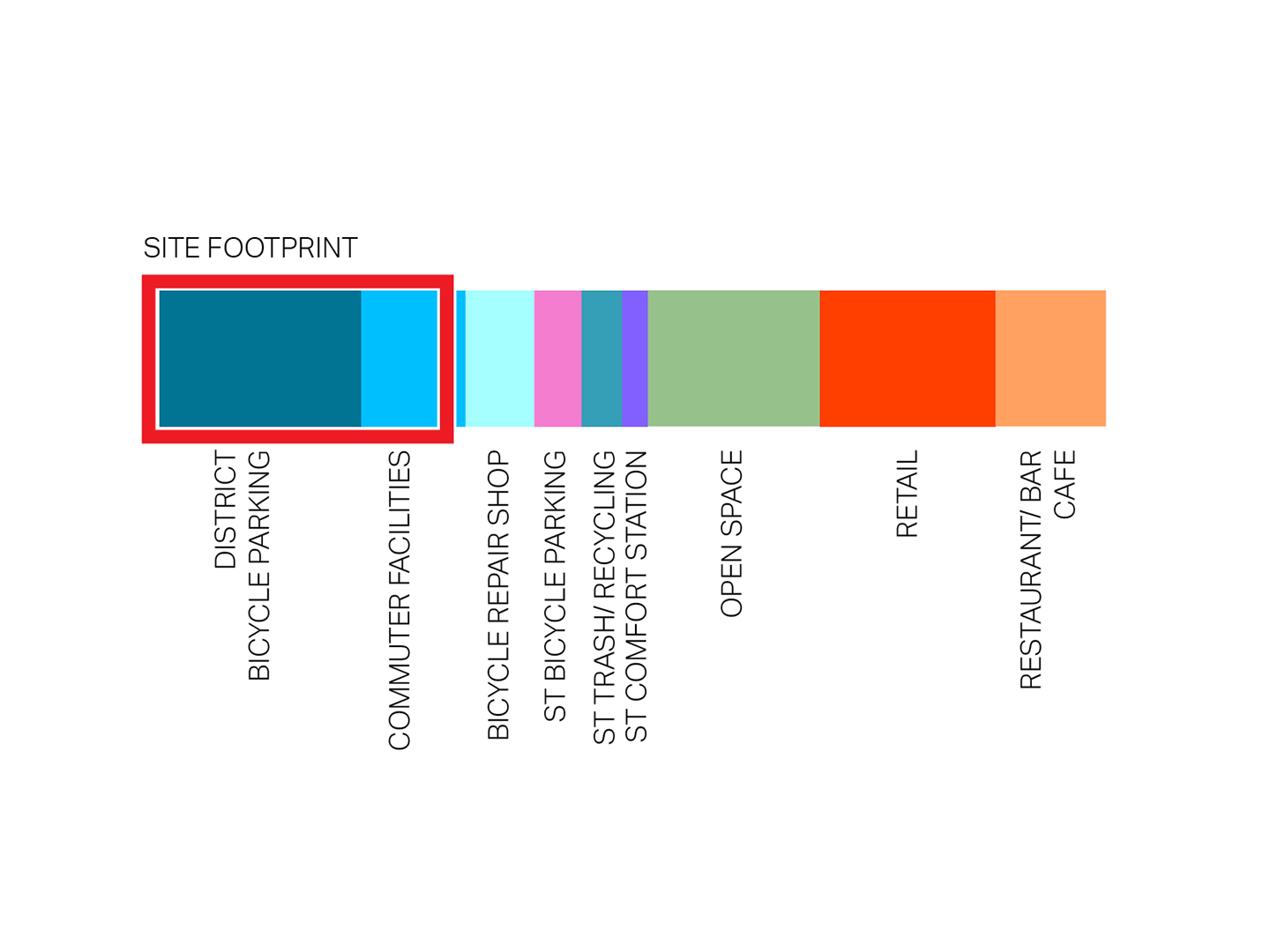
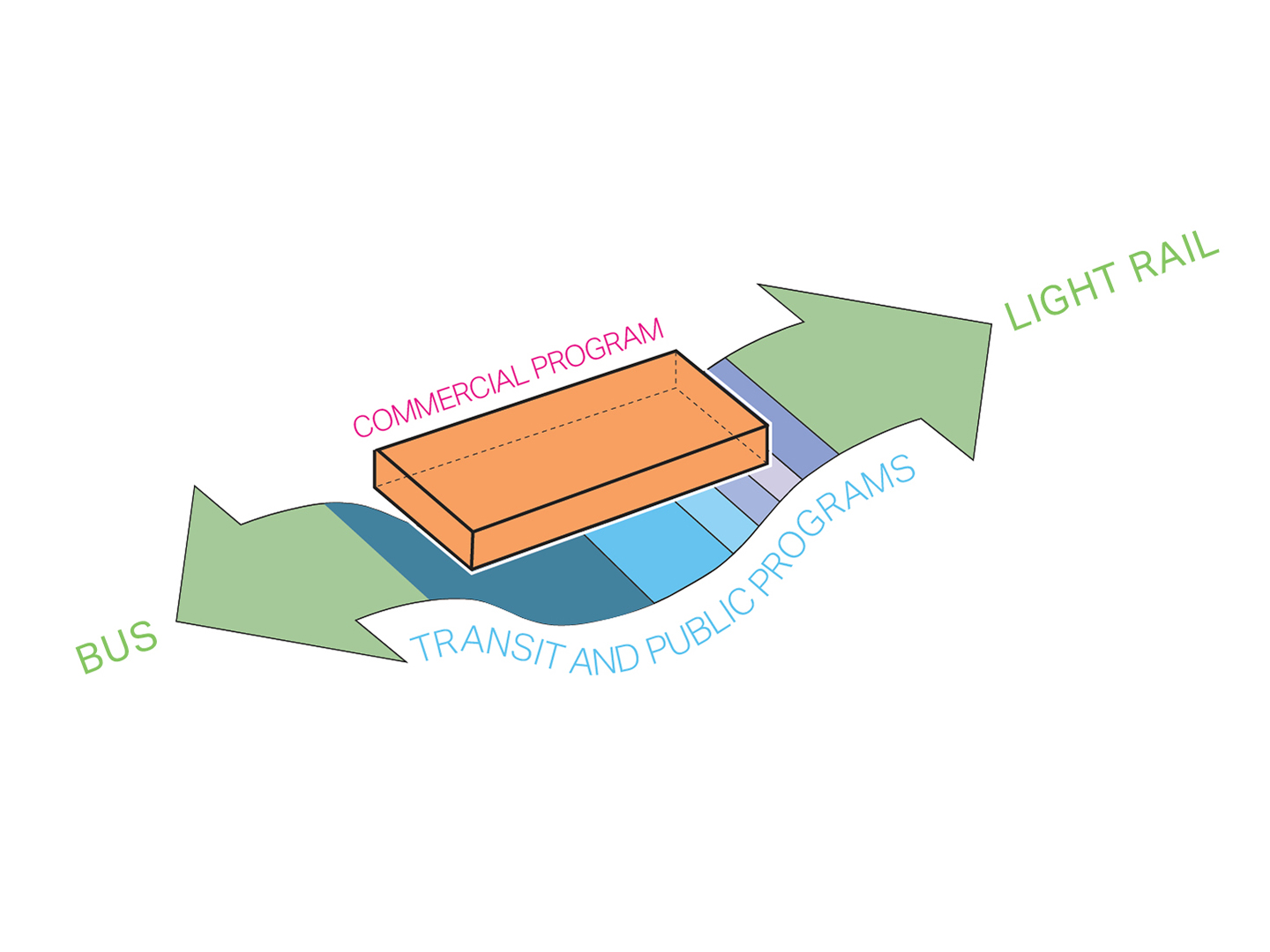

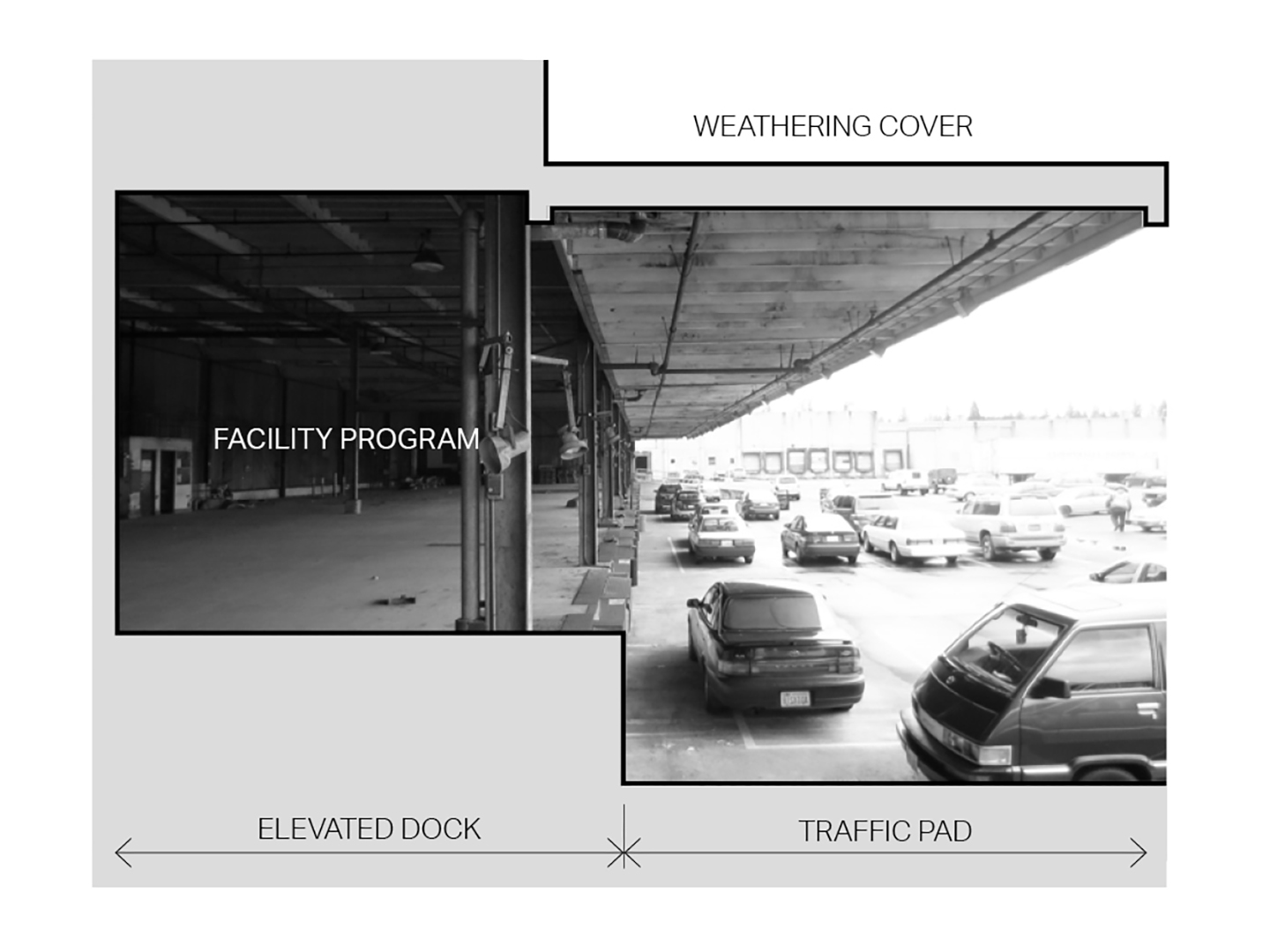
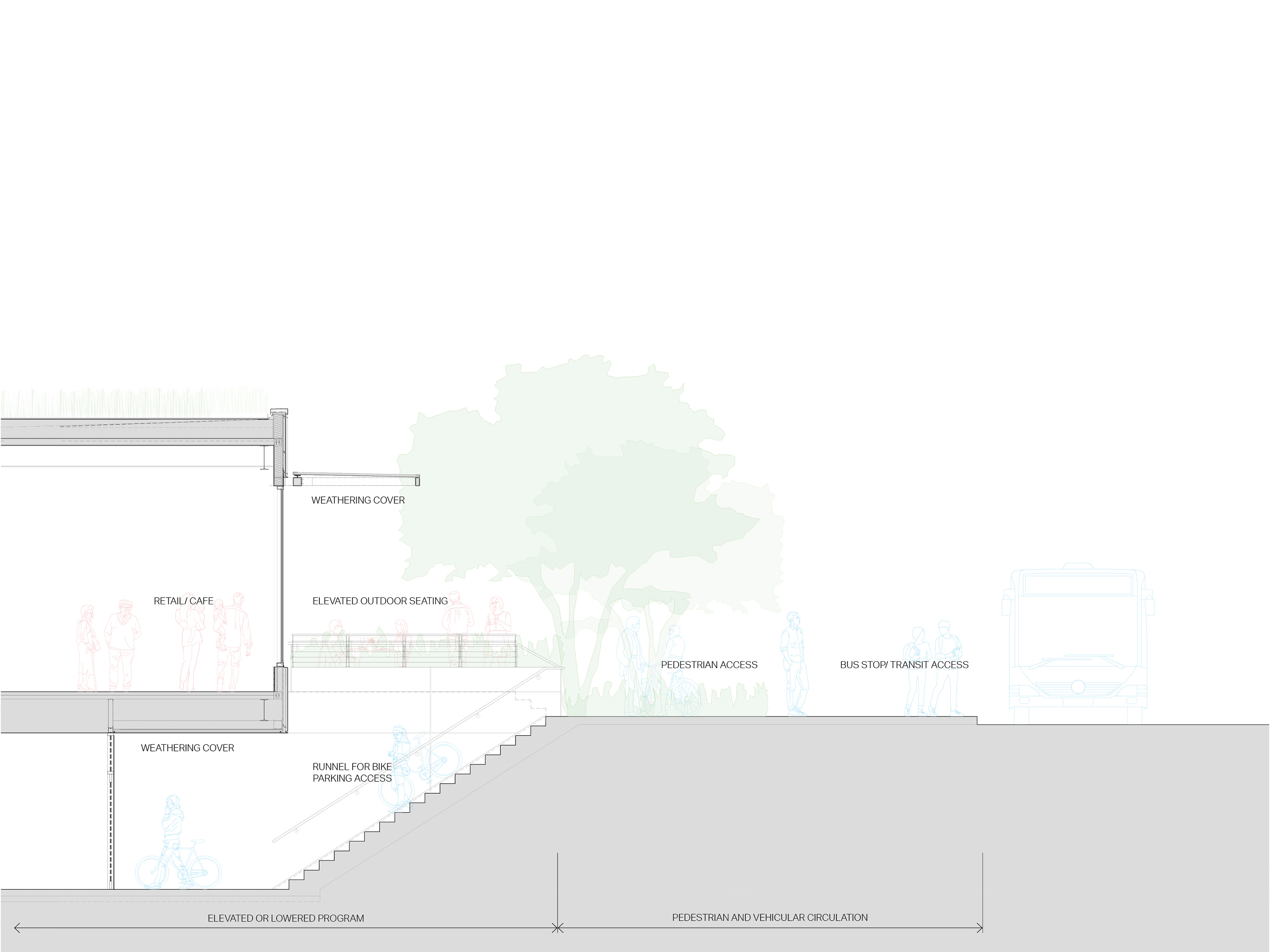
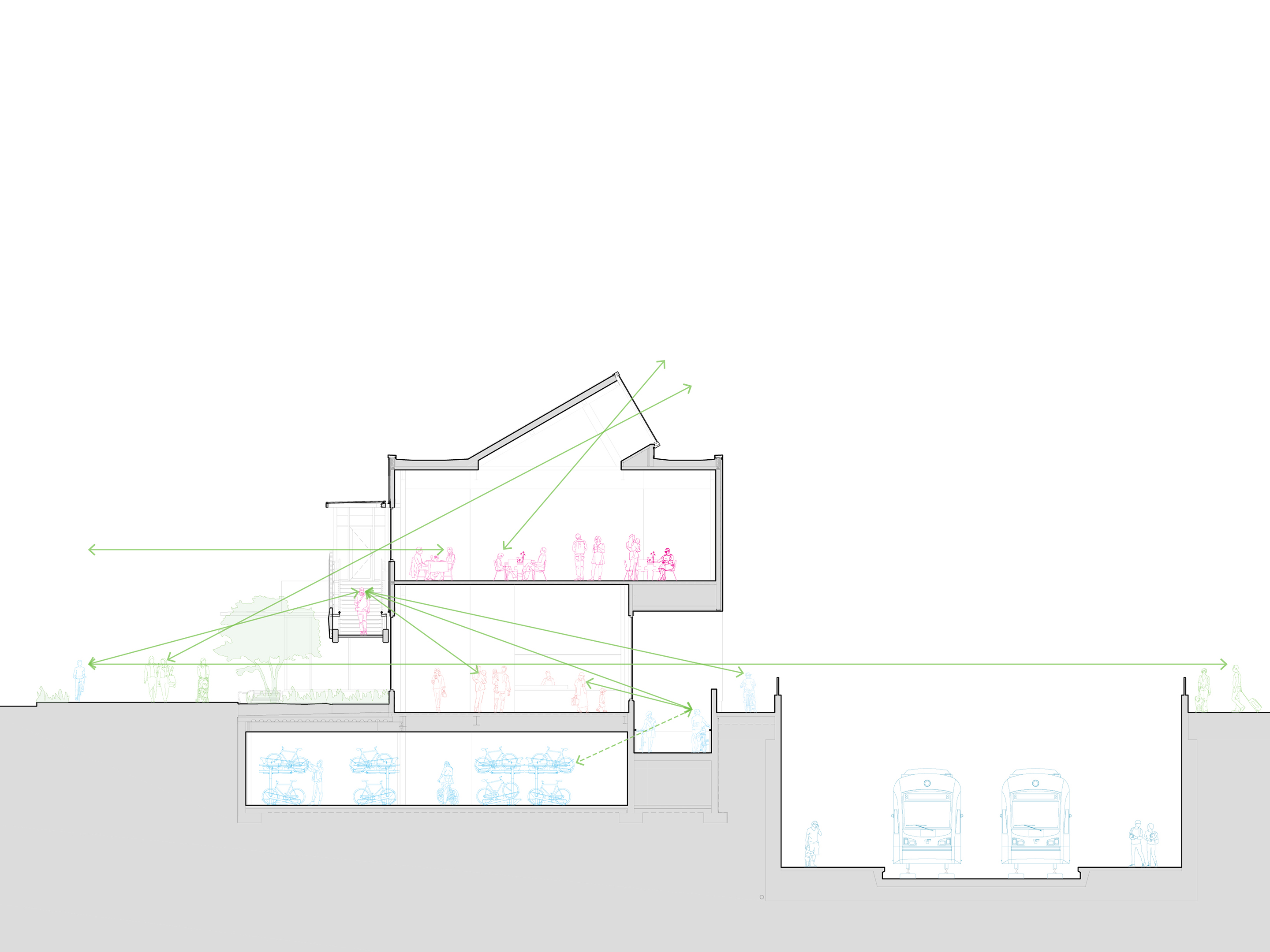
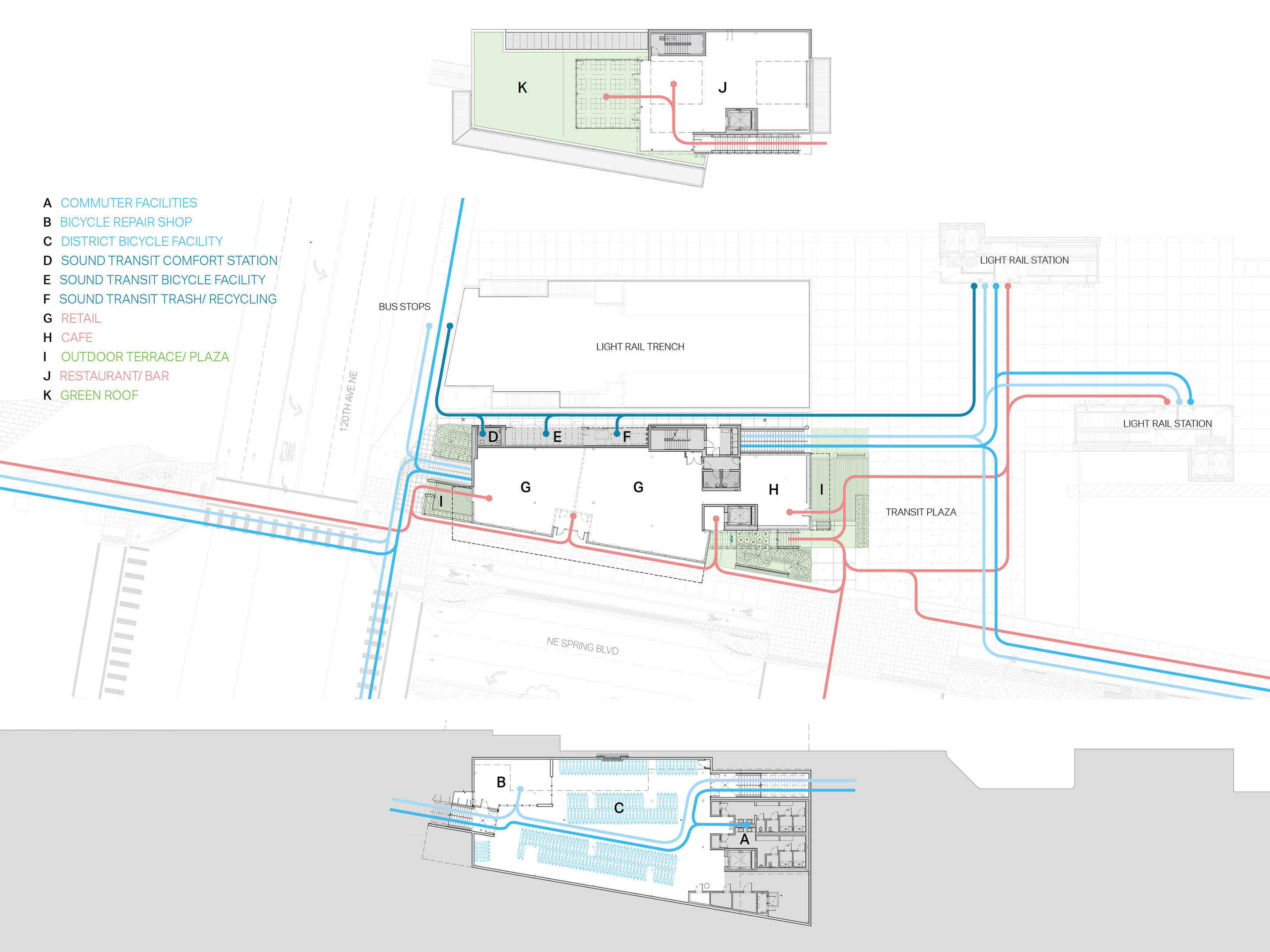
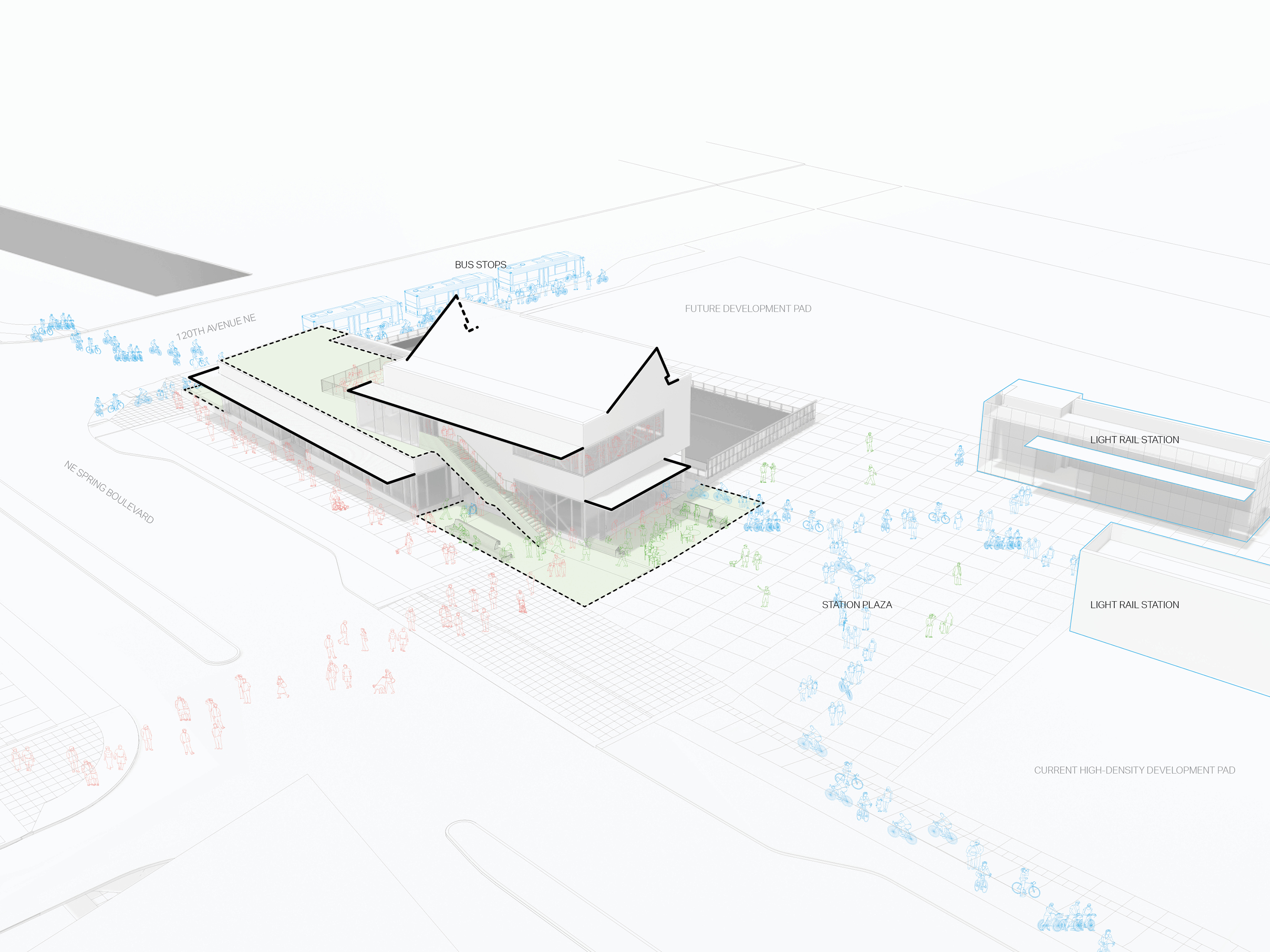
Description
The Spring District Hub is a commuter transit facility, with parking for over 450 bikes, a bike repair shop, and end-of-trip locker and showers. It is a transit employee amenity and service node, with a place for rest and relief, parking for employee bicycles, and facilities for station maintenance and upkeep. And it is a core and shell designed for the small grab-and-go grocer, sidewalk cafes, and rooftop restaurants or bars. The brief required squeezing 16,000 gsf of grade-related programs for diverse user groups and 8,600 gsf of landscapes onto an 11,000 gsf site. The project responded by creating a second ground plane, interwoven with public programs, connecting the new light rail station to the west with critical bus transfers to the east. That single move makes bicycles and transit easier to use, and that can have a big environmental impact. The project brings over three square miles of the Bel-Red corridor within easy reach, without the need for a car. And since each commuter that shifts from car to bike nets a reduction of 1.1 metric tons of CO2e per year, the project enables the removal of 495 metric tons of CO2e annually from the Bel-Red corridor, serving the region beyond its district.
From the adjacent light rail station and from the adjoining bus stop, the Spring District Hub is an identifiable figure in the urban landscape, working to use a very small site to shape wayfinding for transit and an identity for a very large neighborhood. The design leveraged fundamental elements from the district’s history, from weathering cover to durable materials, and reprogrammed those elements with the contemporary requirement of the project’s brief to enable public life more times of the day, more days of the week, and more seasons of the year. It is a framework that is designed to accept change as the Spring District continues to grow.
In September of 2021, Bellevue’s Spring District neighborhood became the second Puget Sound area project to achieve the USGBC’s LEED ND certification. The Spring District Hub was an integral component in meeting the District’s requirements.
From the adjacent light rail station and from the adjoining bus stop, the Spring District Hub is an identifiable figure in the urban landscape, working to use a very small site to shape wayfinding for transit and an identity for a very large neighborhood. The design leveraged fundamental elements from the district’s history, from weathering cover to durable materials, and reprogrammed those elements with the contemporary requirement of the project’s brief to enable public life more times of the day, more days of the week, and more seasons of the year. It is a framework that is designed to accept change as the Spring District continues to grow.
In September of 2021, Bellevue’s Spring District neighborhood became the second Puget Sound area project to achieve the USGBC’s LEED ND certification. The Spring District Hub was an integral component in meeting the District’s requirements.
Information
Location
The Spring District︎︎︎, Bellevue, Washington
Client
Wright Runstad︎︎︎/ WR-SRI 120th North
Status
Design: 2018-2020
Construction: 2020-2021
Program
Transit Facilities, Commuter Facilites, Bicycle Parking (450 units), Neighborhood Amenities, Retail/ Commercial/ Foodservice, Public Space
Size:
16,000gsf; 0.25ac
Collaborators
Landscape Architect: Fazio Associates︎︎︎
Structural Engineer: KPFF︎︎︎
Civil Engineering: JMJ Team︎︎︎
Mobility: Nelson Nygaard︎︎︎
Geotechnical: Hart Crowser︎︎︎
Lighting: PLS︎︎︎
Graphics: Olive Design Studio︎︎︎
Visualization: Studio 216︎︎︎
General Contractor: Foushee︎︎︎
The Spring District︎︎︎, Bellevue, Washington
Client
Wright Runstad︎︎︎/ WR-SRI 120th North
Status
Design: 2018-2020
Construction: 2020-2021
Program
Transit Facilities, Commuter Facilites, Bicycle Parking (450 units), Neighborhood Amenities, Retail/ Commercial/ Foodservice, Public Space
Size:
16,000gsf; 0.25ac
Collaborators
Landscape Architect: Fazio Associates︎︎︎
Structural Engineer: KPFF︎︎︎
Civil Engineering: JMJ Team︎︎︎
Mobility: Nelson Nygaard︎︎︎
Geotechnical: Hart Crowser︎︎︎
Lighting: PLS︎︎︎
Graphics: Olive Design Studio︎︎︎
Visualization: Studio 216︎︎︎
General Contractor: Foushee︎︎︎
Related
Eastsound House
Orcas Island, WASingle-family Residential
Information Coming Soon.
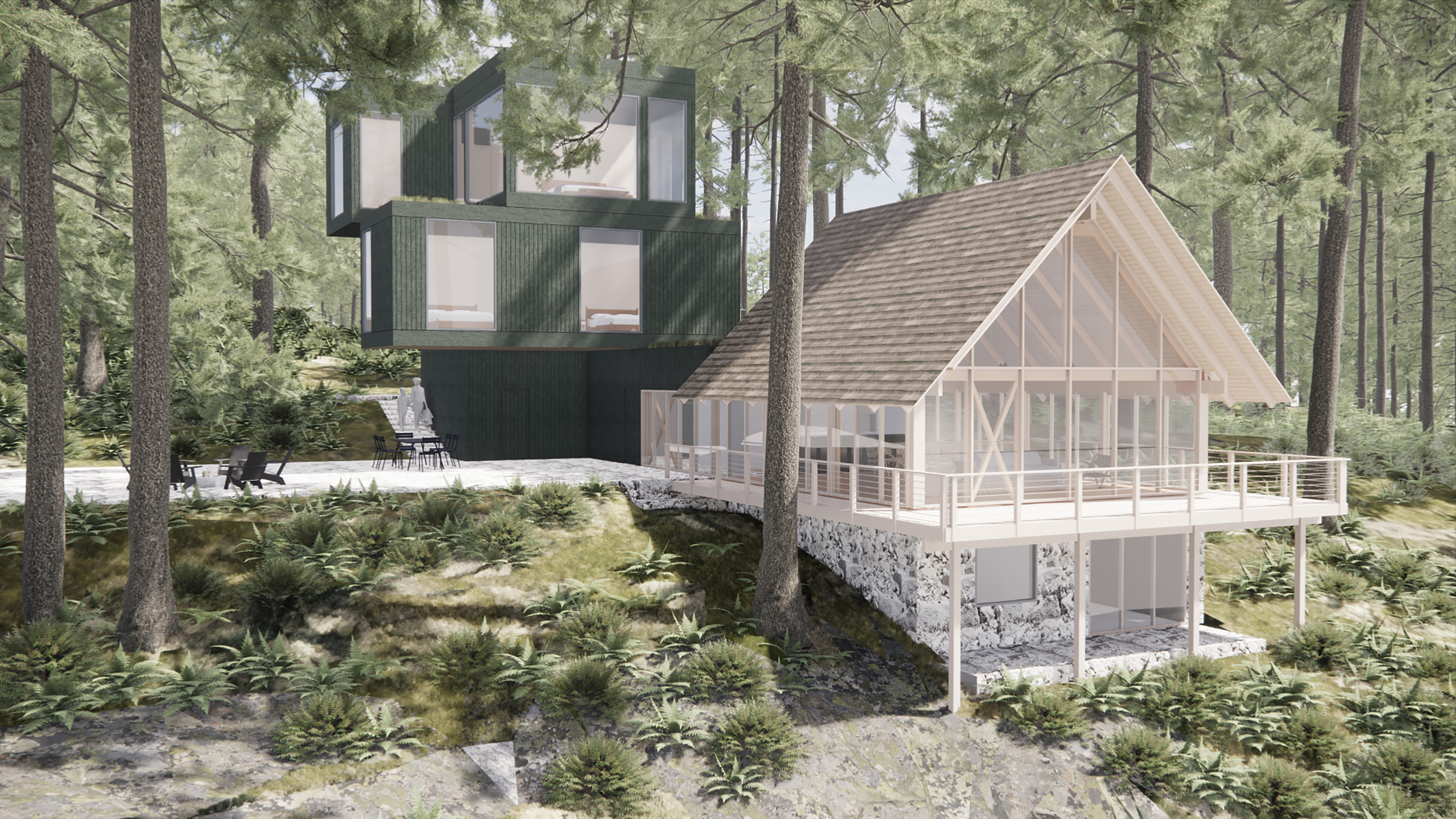

Information
Location
Orcas Island, Washington
Client
Private
Status
Design: 2022-2023
Program
Single-family Residential
Size:
3,000gsf; 1.55ac
Collaborators
Landscape Architect: Pacific Landscape︎︎︎
Structural Engineer: Quantum Consulting Engineers︎︎︎
Surveyor: Holman Land Surveying︎︎︎
Environmental: NW Ecological Services︎︎︎
Civil Engineering: Pacific Engineering︎︎︎
Orcas Island, Washington
Client
Private
Status
Design: 2022-2023
Program
Single-family Residential
Size:
3,000gsf; 1.55ac
Collaborators
Landscape Architect: Pacific Landscape︎︎︎
Structural Engineer: Quantum Consulting Engineers︎︎︎
Surveyor: Holman Land Surveying︎︎︎
Environmental: NW Ecological Services︎︎︎
Civil Engineering: Pacific Engineering︎︎︎
